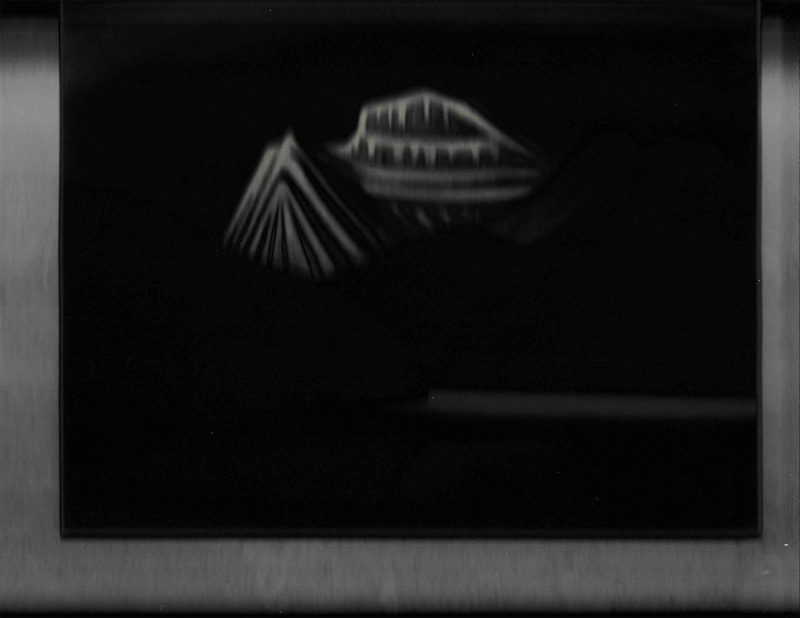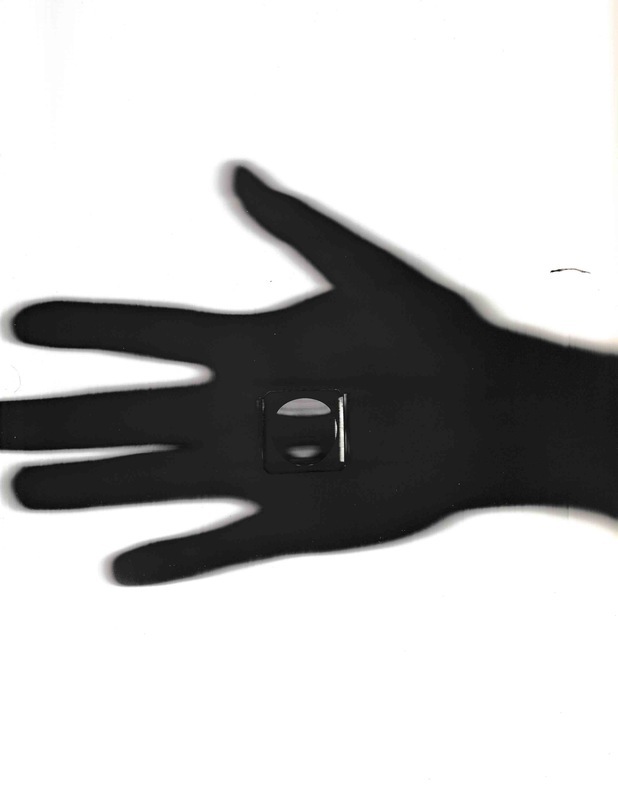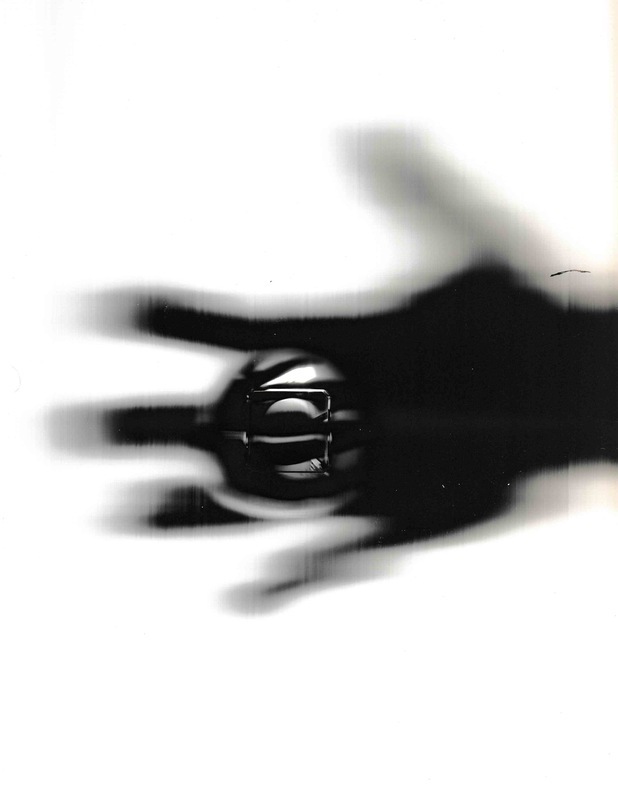Necromancy;
A Hauntology of Grief, Materiality, and Research Creation
Contents: About The Project | What am I doing? | 1. Thinking Interpersonally | 2. Thinking Spectrally | 3. Thinking Aprotensively | Tech
About The Project
Each of the works of art contained on this website was created for my Master’s thesis in Communication and Culture, a joint program offered by York University and Toronto Metropolitan University. Each work was created by photographing objects of sentimental value with a CIS (Contact Image Sensor) printer scanner. Most objects have been distorted, warped, stretched, and abstracted within the image, a result of my interruption and disruption of the object’s scan by physically manipulating the materials, the scanner itself, or the platen cover as the CIS bar carries out its scan.
Throughout the course of my Master’s program, I have been developing what I call, a scanner way of thinking, a research creation methodology that aims to unite frames of hauntology, affect theory, and material culture. These theoretical frames are considered under my critical conceptual metaphor of Necromancy.
What am I doing?
Building out of the methodological frame of autotheory, my thesis work emphasizes personal, auto-ethnographic, and memoir-like writing to ground my theorizations in my own lived experiences of grief, study, and arts-making.
Ultimately, I argue for the synthesis of these methodological and theoretical frames in order to;
1. Contribute to the development of research creation methodologies for future research creation scholars by offering up a theoretical grounding for scanner art as a methodology
2. Provide a unifying theoretical frame for hauntology, autotheory, material culture studies, and affect theory under my own critical conceptual metaphor of necromancy
In doing so, I hope to create spaces in which we can consider new ways of grieving that centre interrelationality, to recognize and emphasize our interconnectedness as living and non-living beings, and to do so through an attention to the enchantment of material objects.
To carry out this necromantic practice, I emphasize three primary scopes of consideration within academic spaces.
1. Thinking Interpersonally
To think interpersonally is to emphasize your connections to others and recognize your role as a single link upon the extensive chains of interaction that make up our social networks. According to Erving Goffman (1959), our presentations of the ‘self’ are filtered through the lens of our interpersonal relationships, shared meaning, cultural backgrounds, and the general tone of our interlocutors. In our day to day interactions “we carefully assess the context of the interaction in order to decide how we will act, what we will say, and how we might try to construct and present ourselves” (Wesch, 22). The interactions we engage in on a daily basis inform hugely important parts of our sense of self.
Goffman then goes on to describe the role of “sign-vehicles”, or the means by which we extract or express certain semiotic information in our interactions with others (Goffman, 1). These are the subtle gestural, visual, and tonal values we glean from others in typical interactions, and precisely that which Wesch finds missing and meaningful in our interactions and our attempts to represent ourselves in the physical and social absence of an audience. Material culture scholar John Robb elaborates on this attention to our interpersonal construction of selfhood by widening our lens to the non-human, to the material in his 2015 chapter What Do Things Want? Object Design as a Middle Range Theory of Material Culture; “people act in a flow of action unfolding over time, and interactions with things form a central part of this flow” (Robb, 167).
Robb writes that objects can contain within them an intuitive, sensory knowledge of their function. While these notions have been challenged in discourses of archaeological presumption, Robb hits on something that I believe contains vital energies of magic within them; that is to say, they contain in them a direct acknowledgement of the humanistic ability to glean and discern social, psychological meanings from materials through their visuality and physicality.
Through an attention to the materials that help compose our innately interactive senses of self, we may be able to tune ourselves in to a post-humanist understanding that the borders and boundaries that separate ourselves and others (whether they are human, non-human, no-longer-human, and so on) can be far more flexible and permeable than much of Western capitalist-colonial society, which thrives on the myth of competitive individualism, dictates. In doing so, in thinking interpersonally, we might open ourselves up to more ethical, less individualistic, and more socially collective minded imaginings of self and being.
2. Thinking Spectrally
French philosopher Jacques Derrida’s 1993 book, Spectres of Marx: The State of the Debt, the Work of Mourning and the New International, is famous for, among many things, coining the term Hauntology. Initially written as a pun on the word ontology, the nature of being, Derrida intended to explore the logic of hauntings in order to apply the metaphorical power of spectres to our social and cultural world. Derrida and other critical spectrality scholars such as Mark Fisher, aim to understand how elements from our social-cultural, political, and economic pasts influence and return to our modern day.
One such scholar, Sadeq Rahimi, has written on the many ways in which our everyday lives are made up of hauntogenic elements, that our lived experiences are often shaped by the many invisibilized and unquantifiable volume of political, economic, and ethical forces that characterize globalized modernity. To make any single choice in our contemporary world is to enter into a nexus of political, economic, social, ecological, and historical decisions and states that have been made far beyond the scope of an individual’s ability to understand.
Inspired by feminist and post-humanist scholarship, I employ autotheoretical and life writing methodologies to engage explicitly with my experiences as innately political and as existing beyond normative, prescriptive, and oppressive definitions of my subjective being as something innately individualistic.
To think spectrally then is to accept the strangeness of loss, embrace the dissonances of grief, and, most importantly, to implement hauntological frames of thinking on our everyday, personal experiences with loss and the past. That is to say, to think spectrally is to understand, expect, and critically negotiate with the many ghosts and spectres that will, over the course of time, innevitably come to haunt you, your work, your arts making practices, your (interpersonal) sense of self, and the many and varied ways you engage with and are shaped by the social, cultural, political, ethical, and, interpersonal forces that surround you.
3. Thinking Aprotensively
Building outward from hauntological ways of thinking as well as from a wide range of scholarship surrounding the ontology and teleological implications of the photograph, asynchronicity and atemporality have become central to my concept of Necromancy. Film critic Andre Bazin has written that at the heart of photography there may lie some form of mummy complex, a drive within the plastic arts to artificially preserve the subject (or artist) from the flow of time, “to stow it away neatly, so to speak, in the hold of life” (p.4-5).
Moreso, Roland Barthes’ formative 1980 book, Camera Lucida explores the strangely a/temporal and innately deathly undercurrent of photography, writing about the inborn surreality of seeing his deceased mother’s childhood photos. Enamoured and estranged by these images, Barthes felt that photographs could both accurately, and inaccurately capture representative documentations of one’s self, preserving only one moment of time, one iteration of our varied and contrary selves. Barthes felt that this ‘untimeliness’ of the photograph was distinctly lacking in ‘protensity’ (as having some continuance in time). That is to say, the photograph, and the moment of its taking, is characterized by a deathliness borne out of a discontinuance in time; the subject of the photograph has been removed from the context of the rest of regular, flowing time, and as such, flattens out the character of its subject.
Indeed, there are many layers of and overlapping discontinuances in time that have characterized my experiences in writing this work during both a period of global quarantine, grief, academic rigor, and in the creation/discovery of my particular research creation methodology of necromancy.
Importantly, the photographs I have taken and collected here, are made up of a different form of temporal discontinuance than those which Barthes outlines. Namely, the simple function of a scanner creates an image across time, rather than in a single, particular moment. Of course, this span of time is still relatively minute in the grand scheme of things, and indeed, even a typical camera’s shutter speed can be manipulated to create long exposure images, but it is the unique aesthetic and technical limitations and capabilities of the scanner that have created my visual and conceptual interest in it as a medium.
Thanks to its high resolution, shallow depth of field, and its ability to represent its subject across time and space (in moving across the scanner face or platen), the scanner is able to represent multiple moments, angles, perspectives, textures, and lighting effects in one single image. Seemingly distorting the subject (or object in my case), the scanner is able to fragment, abstract, and, simulate the destruction of, my subjects, allowing me to interrogate photographic compulsions to preserve, accurately document, and objectively represent the singular truth of a subject.
Technical Credits - CollectionBuilder
This digital collection is built with CollectionBuilder, an open source framework for creating digital collection and exhibit websites that is developed by faculty librarians at the University of Idaho Library following the Lib-Static methodology.
Using the CollectionBuilder-CSV template and the static website generator Jekyll, this project creates an engaging interface to explore driven by metadata.



